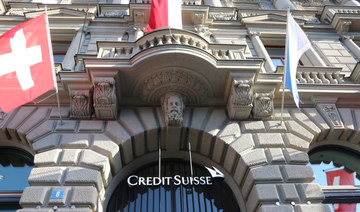LONDON: Investors stepped cautiously into bank stocks on Tuesday, emboldened by the rescue of Credit Suisse, with share prices inching tentatively higher amid continuing concerns about smaller US lenders and further financial market ructions, according to Reuters
After a tumultuous 10 days which culminated in the 3 billion Swiss franc ($3.2 billion) Swiss-regulator-engineered takeover of Credit Suisse by its rival UBS, attention has now shifted to this week’s meeting of the US Federal Reserve.
As concern over the health of US mid-sized lenders lingers, Treasury Secretary Janet Yellen plans to tell bankers later on Tuesday that the country’s banking system is stabilizing after strong actions from regulators.
But she will also say further steps to protect bank depositors may be warranted if smaller institutions suffer deposit runs that threaten more contagion.
“The steps we took were not focused on aiding specific banks or classes of banks. Our intervention was necessary to protect the broader US banking system,” Yellen said in excerpts of prepared remarks to an American Bankers Association conference.
Yellen said she believed the actions by the Federal Deposit Insurance Corp., the US Federal Reserve and the Treasury had reduced the risk of further bank failures.
The demise of 167-year-old Credit Suisse was triggered by the collapse of US lenders Silicon Valley Bank and Signature Bank, and investors are concerned about potential bombs ticking elsewhere in the financial system.
The European Central Bank’s top banking supervisor said euro zone banks should watch their sources of funding or risk being “caught off guard” by rising interest rates.
“Increasing interest rates and quantitative tightening require banks to sharpen their focus on liquidity and funding risks,” said Andrea Enria, in remarks the ECB said were drafted in February, before recent global banking upheavals.
The effects of these were felt on German investor sentiment, which tumbled in March as concerns about a new financial crisis ended a five-month streak of consecutive increases, the ZEW economic research institute said on Tuesday.
“The international financial markets are under strong pressure,” and the high level of uncertainty is reflected in the economic expectations, said ZEW President Achim Wambach.
In Switzerland, the Bankers Association said that credit supply would not be restricted by the demise of Credit Suisse, adding it was convinced the Swiss banking sector still had a “prosperous future.”
Credibility “is not destroyed, but it’s not good,” the association’s chairman Marcel Rohner told a news briefing.
As the rescue of Credit Suisse assuaged the worst fears of systemic contagion, European bank shares rose, while Asian stocks lifted off their lows.
And in a sign of business continuity, Credit Suisse kicked off its three-day annual Asian Investment Conference in Hong Kong, which draws top executives at regional companies.
Shares of beaten-down regional lenders climbed in premarket trade, including First Republic Bank, while big US banks such as JPMorgan, Citigroup and Bank of America also rose before the bell.
’Near Death'
Another burning question among traders and investors is whether the Fed’s relentless rate hikes, which some have blamed for sparking the biggest meltdown in the banking sector since the global financial crisis, might be at an end.
Policymakers from Washington to Europe have repeatedly stressed that the current turmoil is different from the global financial crisis 15 years ago, pointing to banks being better capitalized and funds more easily available.
But the sudden shock means traders have now increased their bets the US central bank will pause its hiking cycle on Wednesday to try to ensure financial stability, although they remain split over whether the Fed will raise its benchmark policy rate.
“The banking sector’s near-death experience over the last two weeks is likely to make Fed officials more measured in their stance on the pace of hikes,” said Standard Chartered head of G10 FX research, Steve Englander.
Top central banks promised at the weekend to provide dollar liquidity to stabilize the financial system to prevent the banking jitters from snowballing into a bigger crisis.
In a global response not seen since the height of the pandemic, the Fed said it had joined central banks in Canada, Britain, Japan, the euro zone and Switzerland in a co-ordinated action to enhance market liquidity.
Meanwhile, JPMorgan Chase & Co. CEO Jamie Dimon is leading talks with other big banks on new efforts to stabilize First Republic Bank, which last week had a $30 billion capital infusion, the Wall Street Journal reported.
First Republic and JPMorgan declined to comment on the report, which cited people familiar with the matter.
A spokesperson for First Republic pointed to an earlier statement where the bank said it was “well-positioned to manage short-term deposit activity.”
In Europe, the investor focus has shifted to the massive blow some Credit Suisse bondholders will take, prompting euro zone and UK banking supervisors to try to stop a rout in the market for convertible bank bonds.
The regulators said owners of this type of debt would only suffer losses after shareholders have been wiped out — unlike at Credit Suisse, whose main regulators are in Switzerland and whose AT1 prospectus made clear that hybrid (AT1) holders would not recover any value.
Nevertheless, lawyers are talking to a number of AT1 bond holders about possible legal action, law firm Quinn Emanuel Urquhart & Sullivan said on Monday.
Danske Bank has advised its private clients not to invest in high yield bonds, citing the risk of substantial capital losses as credit conditions tighten.
The category of high yield bonds includes both corporate and bank bonds, including the AT1 bonds that Credit Suisse will have to write down to zero on the orders of the Swiss regulator as part of the bank’s rescue merger with UBS.






















